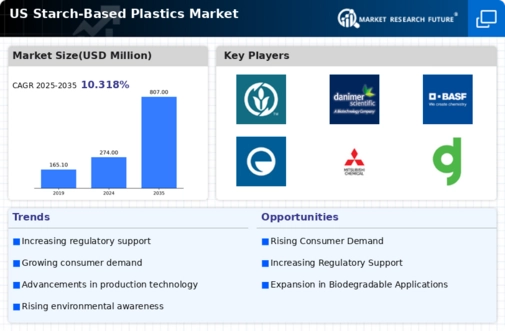The starch based plastics market is currently characterized by a dynamic competitive landscape, driven by increasing consumer demand for sustainable materials and regulatory pressures aimed at reducing plastic waste. Key players such as Cargill (US), BASF (US), and NatureWorks (US) are strategically positioned to leverage their technological capabilities and extensive supply chains to capture market share. Cargill (US) focuses on innovation in biopolymer development, while BASF (US) emphasizes partnerships to enhance its product offerings. NatureWorks (US) is dedicated to expanding its production capacity, which collectively shapes a competitive environment that is increasingly focused on sustainability and technological advancement.
In terms of business tactics, companies are localizing manufacturing to reduce transportation costs and enhance supply chain efficiency. The market structure appears moderately fragmented, with several players vying for dominance. However, the collective influence of major companies like Braskem (US) and Total Corbion PLA (US) suggests a trend towards consolidation, as these firms seek to optimize their operations and expand their market presence.
In November 2025, Cargill (US) announced a partnership with a leading packaging company to develop a new line of compostable packaging solutions. This strategic move is significant as it aligns with the growing consumer preference for environmentally friendly products and positions Cargill (US) as a frontrunner in the sustainable packaging segment. The collaboration is expected to enhance Cargill's (US) market reach and reinforce its commitment to sustainability.
In October 2025, BASF (US) unveiled a new biopolymer that is designed to be fully biodegradable within 12 months. This innovation not only strengthens BASF's (US) product portfolio but also addresses the increasing regulatory scrutiny surrounding plastic waste. The introduction of this biopolymer is likely to attract environmentally conscious consumers and businesses, thereby enhancing BASF's (US) competitive edge in the market.
In September 2025, NatureWorks (US) completed the expansion of its production facility, increasing its capacity to produce Ingeo biopolymer. This expansion is crucial as it allows NatureWorks (US) to meet the rising demand for sustainable materials in various applications, including packaging and consumer goods. The increased capacity positions NatureWorks (US) to capitalize on market growth and reinforces its leadership in the bioplastics sector.
As of December 2025, the competitive trends in the starch based plastics market are increasingly defined by digitalization, sustainability, and the integration of advanced technologies such as AI. Strategic alliances are becoming more prevalent, as companies recognize the need to collaborate to enhance innovation and market responsiveness. Looking ahead, competitive differentiation is likely to evolve from traditional price-based competition to a focus on innovation, technological advancements, and supply chain reliability, reflecting a broader shift towards sustainability and consumer-centric solutions.





















Leave a Comment